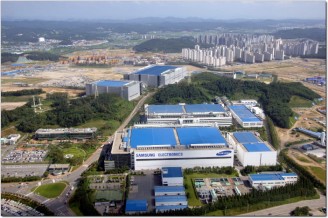
Samsung Electronics Co. today reported it chalked up an operating profit of 5.85 trillion won, the highest quarterly profitability ever on record, on revenues of 45.27 trillion on a consolidated basis in the first quarter of fiscal 2012.
The all-time high of quarterly profitability almost doubled that of a year ago. Compared with the hottest selling 4th quarter season, it is up about 10.2%, too - another sign that Samsung’s financial health is almost immune even from seasonality.
The first quarter revenue was up 22% year-on-year, but down 4.3% quarter on quarter.
The biggest money spinner was mobile phones including smartphones and tablet PCs. Led by explosive demand for its Galaxy and Galaxy Note series smartphones and tablet PCs, Samsung’s IT & Mobile Communication business unit clocked an operating profit of 4.27 trillion won, making up for more than 73% of total profitability. The business unit’s revenue hit 23.22 trillion won, 70% up year-on-year.
Of particular, mobile phone unit raked in 18.90 trillion won in revenues, accounting for more than 90% of the business unit’s total revenue.
The IT & Mobile Communication business unit includes mobile communications, telecommunication systems, IT solutions and digital imaging businesses.
Swinging back to profitability, its display panel business, which was spun off in early April, was also a revenue and profitability gainer.
Samsung recorded an operating profit of 280 billion won on sales of display panels including TFT-LCDs and AMOLEDs, reversing operating losses of 230 billion won and 220 billion won in the first quarter and fourth quarter of fiscal 2011, respectively. Sales of display hit 8.54 trillion won, 31% up year-on-year.
Its semiconductor chip business fell a victim to the weak seasonality and freefalls in the prices of memory chips, however, suffering year-on-year drops in revenues as well as profitability. The semiconductor chip business scored a 54% year-on-year decline in the operating profit to 760 billion won on revenues of 7.98 trillion won, which were also down 13% year-on-year.
Sluggish sales of DRAM chips, especially for PC markets, were the biggest drainer, dragging down memory chip revenues by 17% year-on-year to 4.89 trillion won.
Yet, the business unit could recoup the demand slack in the PC market with strong demand for more lucrative server DRAM chips, staying profitable, while other rivals like SK Hynix, distant No.2 bled red ink for the third quarter in a row.
Its earlier-than-scheduled ramp-up to 30-nanometer-class and 20-nanometer-class process technologies also paid off greatly, enabling the chip maker to get more productivity out of silicon wafer. But also it helped to offset low profitability in commodity DRAM chip market with strong sales of more lucrative specialty DRAM chips like graphics and mobile DRAM chips, as it enabled the chip maker to mix up its
Booming demand for Solid State Drives (SSDs) and Embedded Multimedia Cards (eMMC) also helped the chip business to cushion the market squeeze. “Despite difficult business environments including seasonal low demand for major products such as PCs and TVs amid a global economic slowdown, we achieved record quarterly results based on our differentiated products and technology leadership. We cautiously expect our earnings momentum to continue going forward, as competitiveness in our major businesses is enhanced,” said Robert Yi, Senior Vice President and Head of Investor Relations.
Looking into the second quarter, Samsung expects to improve profitability in the chip business with a recovery in PC DRAM price and by expanding its new product category with mobile application processors based on 32 nanometer-class process technology. Samsung plans to also bolster its competitive edge in mobile phones with the debut of new high-end smartphones, and by reinforcing the full lineup of products and its presence in emerging markets.
As the world’ largest chipmaker plans to break ground to establish a 300mm wafer fabrication facility in China, Samsung has also been on a spending spree, investing 7.8 trillion won in the first quarter. Of the total, 5.8 trillion won was spent to expand, or newly set up semiconductor fabrication facilities, while 1.3 trillion won was earmarked for TFT-LCD production facilities.
Earlier this year, Samsung announced plans to spend a total of 25 trillion won in capex for 2012. Fifteen trillion won will be invested in the Semiconductor Business that consists of Memory and System LSI. For the Display Panel segment, 6.6 trillion won has been allocated for investment.

